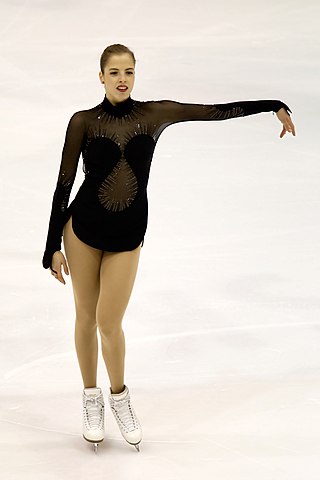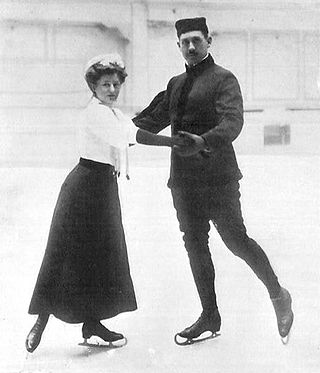
Figure skating is a sport in which individuals, pairs, or groups perform on figure skates on ice. It was the first winter sport to be included in the Olympic Games, when contested at the 1908 Olympics in London. The Olympic disciplines are men's singles, women's singles, pair skating, and ice dance; the four individual disciplines are also combined into a team event, first included in the Winter Olympics in 2014. The non-Olympic disciplines include synchronized skating, Theater on Ice, and four skating. From intermediate through senior-level competition, skaters generally perform two programs, which, depending on the discipline, may include spins, jumps, moves in the field, lifts, throw jumps, death spirals, and other elements or moves.

Ice dance is a discipline of figure skating that historically draws from ballroom dancing. It joined the World Figure Skating Championships in 1952, and became a Winter Olympic Games medal sport in 1976. According to the International Skating Union (ISU), the governing body of figure skating, an ice dance team consists of one woman and one man.
Robert Norris Bowden was a Canadian figure skater.

Figure skating was first contested in the Olympic Games at the 1908 Summer Olympics. Since 1924, the sport has been a part of the Winter Olympic Games.

Pair skating is a figure skating discipline defined by the International Skating Union (ISU) as "the skating of two persons in unison who perform their movements in such harmony with each other as to give the impression of genuine Pair Skating as compared with independent Single Skating". The ISU also states that a pairs team consists of "one Woman and one Man". Pair skating, along with men's and women's single skating, has been an Olympic discipline since figure skating, the oldest Winter Olympic sport, was introduced at the 1908 Summer Olympics in London. The ISU World Figure Skating Championships introduced pair skating in 1908.
The following is a glossary of figure skating terms, sorted alphabetically.
The free skating segment of figure skating, also called the free skate and the long program, is the second of two segments of competitions, skated after the short program. Its duration, across all disciplines, is four minutes for senior skaters and teams, and three and one-half minutes for junior skaters and teams. Vocal music with lyrics is allowed for all disciplines since the 2014—2015 season. The free skating program, across all disciplines, must be well-balanced and include certain elements described and published by the International Skating Union (ISU).
The 6.0 system of judging figure skating was developed during the early days of the sport, when early international competitions consisted of only compulsory figures. Skaters performed each figure three times on each foot, for a total of six, which as writer Ellyn Kestnbaum states, "gave rise to the system of awarding marks based on a standard of 6.0 as perfection". It was used in competitive figure skating until 2004, when it was replaced by the ISU Judging System in international competitions, as a result of the 2002 Winter Olympics figure skating scandal. British ice dancers Jayne Torvill and Christopher Dean earned the most overall 6.0s in ice dance, Midori Ito from Japan has the most 6.0s in single skating, and Irina Rodnina from Russia, with two different partners, has the most 6.0s in pair skating.

Figure skating lifts are required elements in two disciplines of figure skating, pair skating and ice dance. There are five groups of lifts in pair skating, categorized in order of increasing level of difficulty. Judges look for the following when evaluating pair lifts: speed of entry and exit; control of the woman's free leg when she is exiting out of the lift, with the goal of keeping the leg high and sweeping; the position of the woman in the air; the man's footwork; quick and easy changes of position; and the maintenance of flow throughout the lift. Twist lifts are "the most thrilling and exciting component in pair skating". They can also be the most difficult movement to perform correctly. They require more strength and coordination than many other pair elements, and are usually the first or second element in a program. According to the International Skating Union (ISU), "the Woman must be caught in the air at the waist by the Man prior to landing and be assisted to a smooth landing on the ice on a backward outside edge on one foot" during a twist lift. A pair lift and twist lift is required in the short program of pair skating; a well-balanced free skating program in pair skating must include lifts.

Norman Mackie Scott was a Canadian a figure skater who competed in both single skating and pair skating.
Jeanne Chevalier was a Canadian figure skater who competed in both single skating and pair skating. Her pairs partner was Norman M. Scott. As a single skater, she is the 1920 and 1921 Canadian champion. She and Scott won the 1914 Canadian pairs title. Chevalier was part of the four teams that won the Canadian fours championships in 1910, 1920 and 1921.
Melville F. Rogers was a Canadian figure skater and figure skating judge. He competed in the disciplines of single skating, pair skating, ice dancing, and fours. He won the Canadian championship several times.
Ralph Scott McCreath was a Canadian figure skater who competed in single skating, pair skating, ice dancing, and fours. He competed in pairs with Veronica Clarke, Norah McCarthy, Eleanor O'Meara, Bunty Lang, and Betty Chambers, and in fours with fours with Dorothy Caley, Hazel Caley, and Montgomery Wilson, winning the 1939 North American title.
Veronica Clarke was a Canadian figure skater who competed in single skating, pair skating, and four skating. She competed in pairs with Ralph McCreath, winning the North American title in 1937, and three national titles in 1936-1938. In fours, she was the 1938 national fours champion with Constance Wilson-Samuel, Montgomery Wilson, and Ralph McCreath.
The 1972 U.S. Figure Skating Championships was held from January 13–16 at the Long Beach Arena in Long Beach, California. Medals were awarded in three colors: gold (first), silver (second), and bronze (third) in four disciplines – men's singles, ladies' singles, pair skating, and ice dancing – across three levels: senior, junior, and novice.

Kirsten Moore-Towers is a Canadian retired competitive pair skater who competed internationally at the senior level for thirteen seasons from 2009 to 2022. She first achieved distinction partnered with Dylan Moscovitch, winning the 2011 Canadian national title. The two won silver at the 2013 Four Continents Championships, as well as seven medals on the ISU Grand Prix, qualifying to three Grand Prix Finals and finishing fourth at two consecutive World Championships. As part of the Canadian team at the 2014 Winter Olympics, Moore-Towers/Moscovitch won an Olympic silver medal in the figure skating team event.

The 2013 Four Continents Figure Skating Championships was a senior international figure skating competition in the 2012–13 season. It was held at the Osaka Municipal Central Gymnasium in Osaka, Japan on February 6–11. Medals were awarded in the disciplines of men's singles, ladies' singles, pair skating, and ice dancing.

Michael Marinaro is a Canadian retired competitive pair skater. In an eight-year partnership with Kirsten Moore-Towers from 2014 to 2022, he achieved distinction both domestically and internationally, winning three Canadian national titles. Competing internationally, they are two-time Four Continents medallists, and have won medals on both the Grand Prix and Challenger series, including gold at the 2019 Nebelhorn Trophy and the 2017 U.S. International Classic. The two represented Canada at the 2018 and 2022 Winter Olympics.

Evelyn Walsh is a Canadian former competitive pair skater. With Trennt Michaud, she is the 2022 Four Continents bronze medalist and a three-time Canadian national silver medalist.

Trennt Michaud is a Canadian pair skater. With his skating partner, Lia Pereira, he is the 2022 CS Golden Spin of Zagreb bronze medallist and 2023 Canadian national bronze medallist.









